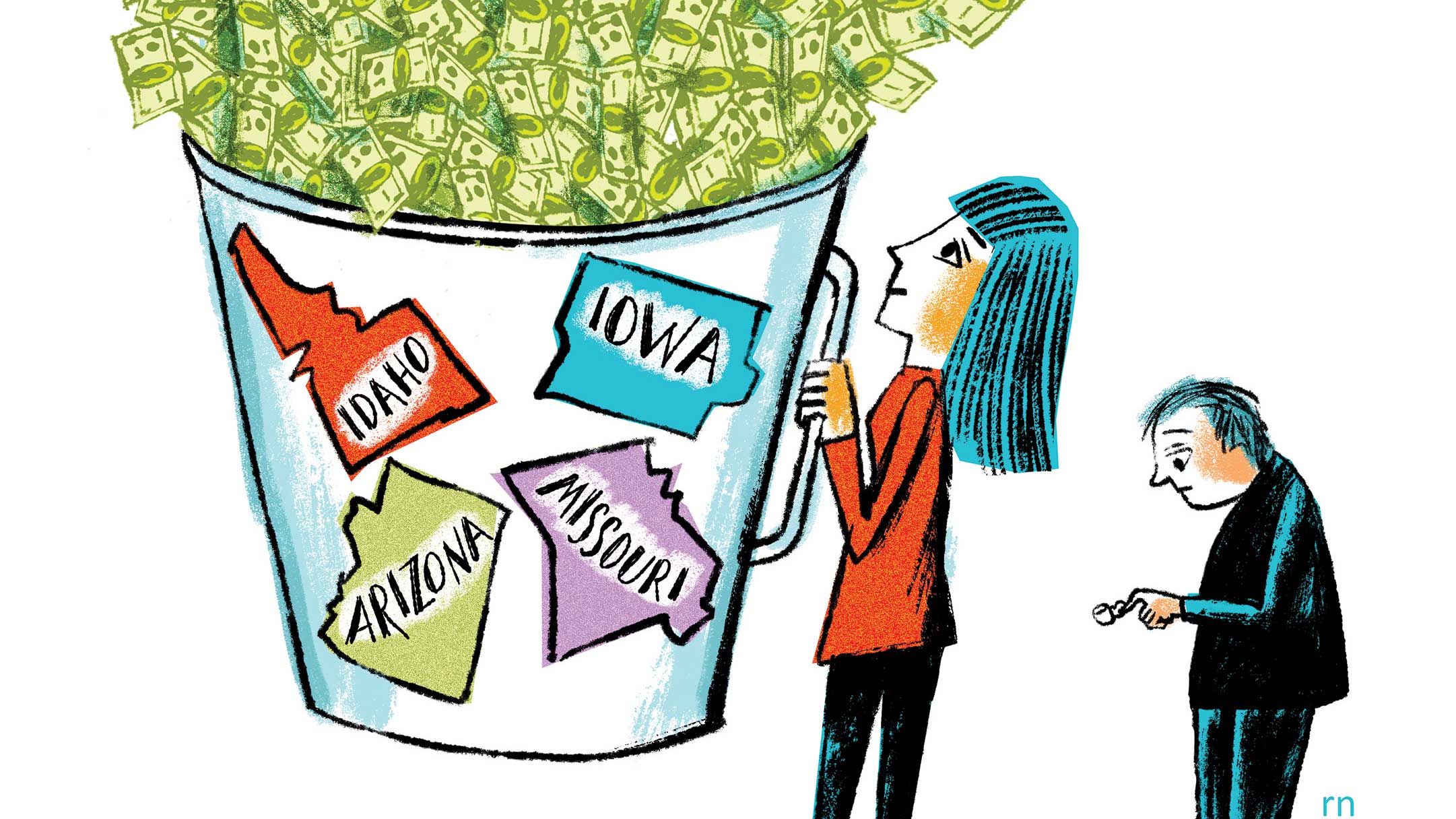What the Midterm Elections Mean to Your Money
Regardless of the results of the election, putting an end to the uncertainty is likely to be a plus for your portfolio.

As Americans head to the polls, it’s probably safe to say that the outcome of the 2018 midterm elections will be among the most closely watched in memory. But, politics aside, what should investors be on the lookout for?
If history is a guide, Americans can expect a power shift in Congress. But history also shows that whether your party is victorious or not, your portfolio is likely to survive the midterms unscathed—and maybe a little ahead. “There’s so much focus on the midterms because of the polarized nature of the electorate,” says Mike Ryan, chief investment officer for the Americas at UBS Global Wealth Management. “Elections matter, but they’re not the only thing and not the most important thing” for stocks, Ryan says.
Incumbent parties tend to lose ground in midterm elections. Since 1910, the party in the White House has lost 31 seats, on average, in the House of Representatives and four seats in the Senate, according to UBS. The Democrats need to flip 23 Republican seats to gain control of the House—and they’re likely to gain a modest majority there, predict UBS and other political handicappers. The Senate, however, will likely remain in Republican control. Just nine GOP seats are up for grabs, compared with 26 for Democrats and left-leaning Independents.
From just $107.88 $24.99 for Kiplinger Personal Finance
Become a smarter, better informed investor. Subscribe from just $107.88 $24.99, plus get up to 4 Special Issues

Sign up for Kiplinger’s Free Newsletters
Profit and prosper with the best of expert advice on investing, taxes, retirement, personal finance and more - straight to your e-mail.
Profit and prosper with the best of expert advice - straight to your e-mail.
In that divided-Congress scenario, to which UBS assigns the highest probability (60%), expect some gridlock when it comes to passing legislation but continued deregulation by means of executive action, as well as further use of tariffs to pressure trading partners. Democratic control of key House committees means the potential launch of investigations against the Trump administration that could roil markets from time to time. The bigger risk for investors is if mild gridlock turns into extreme gridlock. The current government spending agreement expires in September 2019, and Congress will need to act to avoid a repeat of the fiscal-cliff stalemate that sent Standard & Poor’s 500-stock index tumbling 18% in 2011.
What is likely off the table with a Democratic House and Republican Senate is tax reform 2.0, which would make certain provisions of the 2017 tax law permanent, locking in individual and small business tax cuts. Social Security and Medicare reforms, which might have helped offset the effect of the tax cuts, are also likely off the table.
There are a couple of areas of likely agreement or at least compromise between the parties, UBS says. One is spending for infrastructure, which would benefit industrial firms. The other is drug price controls, which could pressure pharmaceutical stocks. A united Congress under a president of the same party is the best outcome for stocks historically. But even following elections in which majority rule changes in Congress, the market tends to do just fine, according to research firm CFRA.
In those instances, going back to 1946, the S&P 500 has gained an average of nearly 6% in the final quarter of a midterm election year and 13% in the year following the election.
Whatever you do, don’t let a fixation on politics distract you from matters more important to the market, such as the pace of earnings and economic growth, say strategists at Morgan Stanley. In a midterm election analysis, they write: “We think investors will fare better focusing on fundamentals and the Fed instead of the ballot box.”
Profit and prosper with the best of Kiplinger's advice on investing, taxes, retirement, personal finance and much more. Delivered daily. Enter your email in the box and click Sign Me Up.

Anne Kates Smith brings Wall Street to Main Street, with decades of experience covering investments and personal finance for real people trying to navigate fast-changing markets, preserve financial security or plan for the future. She oversees the magazine's investing coverage, authors Kiplinger’s biannual stock-market outlooks and writes the "Your Mind and Your Money" column, a take on behavioral finance and how investors can get out of their own way. Smith began her journalism career as a writer and columnist for USA Today. Prior to joining Kiplinger, she was a senior editor at U.S. News & World Report and a contributing columnist for TheStreet. Smith is a graduate of St. John's College in Annapolis, Md., the third-oldest college in America.
-
 3 Major Changes to the Charitable Deduction in 2026
3 Major Changes to the Charitable Deduction in 2026Tax Breaks About 144 million Americans may qualify for the 2026 universal charity deduction, while high earners face new IRS limits. Here's what to know.
-
 Where to Stash Cash as Yields Fall, According to Advisers
Where to Stash Cash as Yields Fall, According to AdvisersYour best options depend on how soon you'll need the money and your tolerance for risk.
-
 Control vs Protection Quiz: Which Trust Do You Need?
Control vs Protection Quiz: Which Trust Do You Need?Quiz Take this simple quiz to discover whether a revocable or irrevocable trust should be the cornerstone of your estate plan.
-
 Kiplinger's Tax Map for Middle-Class Families: About Our Methodology
Kiplinger's Tax Map for Middle-Class Families: About Our Methodologystate tax The research behind our judgments.
-
 Retirees, Make These Midyear Moves to Cut Next Year's Tax Bill
Retirees, Make These Midyear Moves to Cut Next Year's Tax BillTax Breaks Save money next April by making these six hot-as-July tax moves.
-
 Estimated Payments or Withholding in Retirement? Here's Some Guidance
Estimated Payments or Withholding in Retirement? Here's Some GuidanceBudgeting You generally must pay taxes throughout the year on your retirement income. But it isn't always clear whether withholding or estimated tax payments is the best way to pay.
-
 How to Cut Your 2021 Tax Bill
How to Cut Your 2021 Tax BillTax Breaks Our guidance could help you claim a higher refund or reduce the amount you owe.
-
 Why This Tax Filing Season Could Be Ugly
Why This Tax Filing Season Could Be UglyCoronavirus and Your Money National Taxpayer Advocate Erin M. Collins warns the agency will continue to struggle with tight budgets and backlogs. Her advice: File electronically!
-
 Con Artists Target People Who Owe The IRS Money
Con Artists Target People Who Owe The IRS MoneyScams In one scheme, thieves will offer to "help" you pay back taxes, only to leave you on the hook for expensive fees in addition to the taxes.
-
 Cash-Rich States Lower Taxes
Cash-Rich States Lower TaxesTax Breaks The economic turnaround sparked a wave of cuts in state tax rates. But some say the efforts could backfire.
-
 The Financial Effects of Losing a Spouse
The Financial Effects of Losing a SpouseFinancial Planning Even amid grief, it's important to reassess your finances. With the loss of your spouse's income, you may find yourself in a lower tax bracket or that you qualify for new deductions or credits.